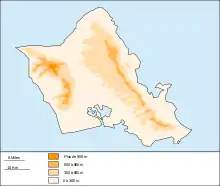| Great Oʻahu crake Temporal range: Holocene | |
|---|---|
Extinct (Early 11th century) | |
| Scientific classification | |
| Domain: | Eukaryota |
| Kingdom: | Animalia |
| Phylum: | Chordata |
| Class: | Aves |
| Order: | Gruiformes |
| Family: | Rallidae |
| Genus: | Porzana |
| Species: | †P. ralphorum |
| Binomial name | |
| †Porzana ralphorum (Olson, 1973) | |
 | |
| Island of Oʻahu. | |
The Great Oʻahu crake or Great Oʻahu rail (Porzana ralphorum) is an extinct bird species that was endemic to the island of Oʻahu in Hawaiʻi. It was one of two flightless rails that had survived on the island until the arrival of people in 200 C.E.
It was the larger of two species of rail found on the island of Oʻahu. There were several specimens of this bird found in early settlements. It was 1.5 feet (0.46 m) tall, had a 1-inch (2.5 cm) beak, and a neck 9 inches (23 cm) long. Its wings were on average less than 3 inches (7.6 cm) long, making it flightless. The Great Oʻahu crake was probably a brown, grey, and black bird like its recently extinct relatives the Hawaiian and Laysan rails. It probably fed on the fruits, leaves, and flowers of trees that fell onto the ground.
The cause of extinction is not very well known, but we can speculate that it was hunted for meat, and that its bones and feathers were used for decoration. It may also have been attacked by the Polynesian rats that were introduced by early settlers.
External links
- BirdLife International (2004). "Porzana ralphorum". IUCN Red List of Threatened Species. 2004. Retrieved 9 November 2006. Database entry includes justification for why this species is extinct